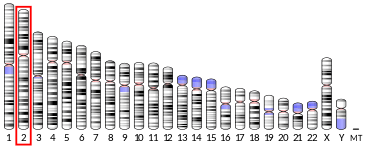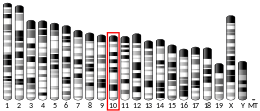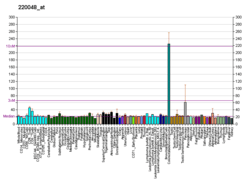Ectodysplasin A receptor
Ectodysplasin A receptor (EDAR) is a protein that in humans is encoded by the EDAR gene. EDAR is a cell surface receptor for ectodysplasin A which plays an important role in the development of ectodermal tissues such as the skin.[5][6][7] It is structurally related to members of the TNF receptor superfamily.[8]
Function
EDAR and other genes provide instructions for making proteins that work together during embryonic development. These proteins form part of a signaling pathway that is critical for the interaction between two cell layers, the ectoderm and the mesoderm. In the early embryo, these cell layers form the basis for many of the body's organs and tissues. Ectoderm-mesoderm interactions are essential for the proper formation of several structures that arise from the ectoderm, including the skin, hair, nails, teeth, and sweat glands.[7]
Clinical significance
Mutation in this gene have been associated with hypohidrotic ectodermal dysplasia, a disorder characterized by a lower density of sweat glands.[7]
Derived EDAR allele
A derived G-allele point mutation (SNP) with pleiotropic effects in EDAR, 370A or rs3827760, found in most modern East Asians and Native Americans but not common in African or European populations, is thought to be one of the key genes responsible for a number of differences between these populations, including the thicker hair, more numerous sweat glands, smaller breasts, and the Sinodont dentition (so-called shovel incisors) characteristic of East Asians.[9] It has been hypothesized that natural selection favored this allele during the last ice age in a population of people living in isolation in Beringia, as it may play a role in the synthesis of breast milk under Vitamin D-poor conditions.[10][11][12] The 370A mutation arose in humans approximately 30,000 years ago, and now is found in 93% of Han Chinese and in the majority of people in nearby Asian populations. This mutation is also implicated in ear morphology differences and reduced chin protrusion.[13] The derived G-allele is a mutation of the ancestral A-allele, the version found in most modern non-East Asian and non-Native American populations.
In a 2015 study, three (of six) ancient DNA samples (7,900-7,500 BP) from Motala, Sweden; two (3300–3000 BC) from the Afanasevo culture and one (400–200 BC) Scythian sample were found to carry the rs3827760 mutation.[14]
In a 2018 study, several ancient DNA samples from the Americas, including USR1 from the Upward Sun River site, Anzick-1, and the 9,600 BP individual from Lapa do Santo, were found to not carry the derived allele. This suggests that the increased frequency of the derived allele occurred independently in both East Asia and the Americas.[15]
See also
References
- GRCh38: Ensembl release 89: ENSG00000135960 - Ensembl, May 2017
- GRCm38: Ensembl release 89: ENSMUSG00000003227 - Ensembl, May 2017
- "Human PubMed Reference:". National Center for Biotechnology Information, U.S. National Library of Medicine.
- "Mouse PubMed Reference:". National Center for Biotechnology Information, U.S. National Library of Medicine.
- Monreal AW, Ferguson BM, Headon DJ, Street SL, Overbeek PA, Zonana J (Aug 1999). "Mutations in the human homologue of mouse dl cause autosomal recessive and dominant hypohidrotic ectodermal dysplasia". Nature Genetics. 22 (4): 366–9. doi:10.1038/11937. PMID 10431241.
- Aswegan AL, Josephson KD, Mowbray R, Pauli RM, Spritz RA, Williams MS (Nov 1997). "Autosomal dominant hypohidrotic ectodermal dysplasia in a large family". American Journal of Medical Genetics. 72 (4): 462–7. doi:10.1002/(SICI)1096-8628(19971112)72:4<462::AID-AJMG17>3.0.CO;2-P. PMID 9375732.
- "Entrez Gene: EDAR ectodysplasin A receptor".
- Online Mendelian Inheritance in Man (OMIM): 604095
- Kamberov YG, Wang S, Tan J, Gerbault P, Wark A, Tan L, Yang Y, Li S, Tang K, Chen H, Powell A, Itan Y, Fuller D, Lohmueller J, Mao J, Schachar A, Paymer M, Hostetter E, Byrne E, Burnett M, McMahon AP, Thomas MG, Lieberman DE, Jin L, Tabin CJ, Morgan BA, Sabeti PC (Feb 2013). "Modeling recent human evolution in mice by expression of a selected EDAR variant". Cell. 152 (4): 691–702. doi:10.1016/j.cell.2013.01.016. PMC 3575602. PMID 23415220.
- Lozovschi, Alexandra (24 April 2018). "Ancient Teeth Reveal Breastfeeding-Related Gene Helped Early Americans Survive The Ice Age [Study]". Inquisitr. Retrieved 25 April 2018.
- Nicholas Wade (February 14, 2013). "East Asian Physical Traits Linked to 35,000-Year-Old Mutation". The New York Times. Retrieved February 15, 2013.
- Hlusko, Leslea J.; Carlson, Joshua P.; Chaplin, George; Elias, Scott A.; Hoffecker, John F.; Huffman, Michaela; Jablonski, Nina G.; Monson, Tesla A.; O’Rourke, Dennis H. (2018-05-08). "Environmental selection during the last ice age on the mother-to-infant transmission of vitamin D and fatty acids through breast milk". Proceedings of the National Academy of Sciences. 115 (19): E4426–E4432. doi:10.1073/pnas.1711788115. ISSN 0027-8424. PMC 5948952. PMID 29686092.
- Adhikari, Kaustubh (19 May 2016). "A genome-wide association scan implicates DCHS2, RUNX2, GLI3, PAX1 and EDAR in human facial variation". Nature Communications. 7: 11616. doi:10.1038/ncomms11616. PMC 4874031. PMID 27193062.
- Mathieson, Iain; Lazaridis, Iosif (23 November 2015). "Genome-wide patterns of selection in 230 ancient Eurasians". Nature. 528 (7583): 499–503. doi:10.1038/nature16152. PMC 4918750. PMID 26595274.
- Posth, Cosimo; Nakatsuka, Nathan; Lazaridis, Iosif; Skoglund, Pontus; Mallick, Swapan; Lamnidis, Thiseas C.; Rohland, Nadin; Nägele, Kathrin; Adamski, Nicole; Bertolini, Emilie; Broomandkhoshbacht, Nasreen; Cooper, Alan; Culleton, Brendan J.; Ferraz, Tiago; Ferry, Matthew; Furtwängler, Anja; Haak, Wolfgang; Harkins, Kelly; Harper, Thomas K.; Hünemeier, Tábita; Lawson, Ann Marie; Llamas, Bastien; Michel, Megan; Nelson, Elizabeth; Oppenheimer, Jonas; Patterson, Nick; Schiffels, Stephan; Sedig, Jakob; Stewardson, Kristin; Talamo, Sahra; Wang, Chuan-Chao; Hublin, Jean-Jacques; Hubbe, Mark; Harvati, Katerina; Nuevo Delaunay, Amalia; Beier, Judith; Francken, Michael; Kaulicke, Peter; Reyes-Centeno, Hugo; Rademaker, Kurt; Trask, Willa R.; Robinson, Mark; Gutierrez, Said M.; Prufer, Keith M.; Salazar-García, Domingo C.; Chim, Eliane N.; Müller Plumm Gomes, Lisiane; Alves, Marcony L.; Liryo, Andersen; Inglez, Mariana; Oliveira, Rodrigo E.; Bernardo, Danilo V.; Barioni, Alberto; Wesolowski, Veronica; Scheifler, Nahuel A.; Rivera, Mario A.; Plens, Claudia R.; Messineo, Pablo G.; Figuti, Levy; Corach, Daniel; Scabuzzo, Clara; Eggers, Sabine; DeBlasis, Paulo; Reindel, Markus; Méndez, César; Politis, Gustavo; Tomasto-Cagigao, Elsa; Kennett, Douglas J.; Strauss, André; Fehren-Schmitz, Lars; Krause, Johannes; Reich, David (2018). "Reconstructing the Deep Population History of Central and South America". Cell. Elsevier BV. 175 (5): 1185–1197.e22. doi:10.1016/j.cell.2018.10.027. hdl:10550/67985. ISSN 0092-8674. PMC 6327247. PMID 30415837.
Further reading
- Thesleff I, Mikkola ML (May 2002). "Death receptor signaling giving life to ectodermal organs". Science's STKE. 2002 (131): PE22. doi:10.1126/stke.2002.131.pe22. PMID 11997580.
- Ho L, Williams MS, Spritz RA (May 1998). "A gene for autosomal dominant hypohidrotic ectodermal dysplasia (EDA3) maps to chromosome 2q11-q13". American Journal of Human Genetics. 62 (5): 1102–6. doi:10.1086/301839. PMC 1377096. PMID 9545409.
- Kumar A, Eby MT, Sinha S, Jasmin A, Chaudhary PM (Jan 2001). "The ectodermal dysplasia receptor activates the nuclear factor-kappaB, JNK, and cell death pathways and binds to ectodysplasin A". The Journal of Biological Chemistry. 276 (4): 2668–77. doi:10.1074/jbc.M008356200. PMID 11035039.
- Yan M, Wang LC, Hymowitz SG, Schilbach S, Lee J, Goddard A, de Vos AM, Gao WQ, Dixit VM (Oct 2000). "Two-amino acid molecular switch in an epithelial morphogen that regulates binding to two distinct receptors". Science. 290 (5491): 523–7. doi:10.1126/science.290.5491.523. PMID 11039935.
- Elomaa O, Pulkkinen K, Hannelius U, Mikkola M, Saarialho-Kere U, Kere J (Apr 2001). "Ectodysplasin is released by proteolytic shedding and binds to the EDAR protein". Human Molecular Genetics. 10 (9): 953–62. doi:10.1093/hmg/10.9.953. PMID 11309369.
- Koppinen P, Pispa J, Laurikkala J, Thesleff I, Mikkola ML (Oct 2001). "Signaling and subcellular localization of the TNF receptor Edar". Experimental Cell Research. 269 (2): 180–92. doi:10.1006/excr.2001.5331. PMID 11570810.
- Headon DJ, Emmal SA, Ferguson BM, Tucker AS, Justice MJ, Sharpe PT, Zonana J, Overbeek PA (2002). "Gene defect in ectodermal dysplasia implicates a death domain adapter in development". Nature. 414 (6866): 913–6. doi:10.1038/414913a. PMID 11780064.
- Yan M, Zhang Z, Brady JR, Schilbach S, Fairbrother WJ, Dixit VM (Mar 2002). "Identification of a novel death domain-containing adaptor molecule for ectodysplasin-A receptor that is mutated in crinkled mice". Current Biology. 12 (5): 409–13. doi:10.1016/S0960-9822(02)00687-5. PMID 11882293.
- Sinha SK, Zachariah S, Quiñones HI, Shindo M, Chaudhary PM (Nov 2002). "Role of TRAF3 and -6 in the activation of the NF-kappa B and JNK pathways by X-linked ectodermal dysplasia receptor". The Journal of Biological Chemistry. 277 (47): 44953–61. doi:10.1074/jbc.M207923200. PMID 12270937.
- Shu H, Chen S, Bi Q, Mumby M, Brekken DL (Mar 2004). "Identification of phosphoproteins and their phosphorylation sites in the WEHI-231 B lymphoma cell line". Molecular & Cellular Proteomics. 3 (3): 279–86. doi:10.1074/mcp.D300003-MCP200. PMID 14729942.
- Zhang Z, Henzel WJ (Oct 2004). "Signal peptide prediction based on analysis of experimentally verified cleavage sites". Protein Science. 13 (10): 2819–24. doi:10.1110/ps.04682504. PMC 2286551. PMID 15340161.
- Hashimoto T, Cui CY, Schlessinger D (Apr 2006). "Repertoire of mouse ectodysplasin-A (EDA-A) isoforms". Gene. 371 (1): 42–51. doi:10.1016/j.gene.2005.11.003. PMID 16423472.
- Chassaing N, Bourthoumieu S, Cossee M, Calvas P, Vincent MC (Mar 2006). "Mutations in EDAR account for one-quarter of non-ED1-related hypohidrotic ectodermal dysplasia". Human Mutation. 27 (3): 255–9. doi:10.1002/humu.20295. PMID 16435307.
- Tariq M, Wasif N, Ahmad W (Jul 2007). "A novel deletion mutation in the EDAR gene in a Pakistani family with autosomal recessive hypohidrotic ectodermal dysplasia". The British Journal of Dermatology. 157 (1): 207–9. doi:10.1111/j.1365-2133.2007.07949.x. PMID 17501952.




